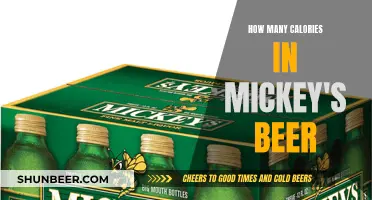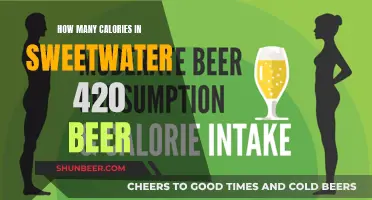
Beer is a beloved beverage for many, but it can also be high in calories. The term beer belly didn't come from nowhere! The calories in beer primarily come from two sources: alcohol and carbohydrates. The general rule is that the higher the ABV, the more calories in your beer. This is because alcohol contains a lot of calories, with each gram of alcohol containing around seven calories. This is almost as calorific as a gram of pure fat.
The more alcohol a beer contains, the more calories it will have. For example, a 12-ounce beer with 5% ABV will have around 150 calories, while the same size beer with 8% ABV will have about 200 calories.
| Characteristics | Values |
|---|---|
| ABV calculation | ABV% x 2.5 x ounces of beer |
| ABV calculation example | 16 ounces, 6% ABV = 240 calories |
| ABV range | 0.5% to 45% |
| ABV and calories | Higher ABV = More Calories |
| Calories in alcohol | 1 gram = 7 calories |
| Calories in sugar | 1 gram = 4 calories |
| Calories from alcohol | 60% |
| Calories from carbohydrates | 40% |
| Calories in a typical 12 oz beer | 140 calories |
| Calories in a pint of beer | 215 calories |
What You'll Learn

Calculating beer calories
Beer is a much-loved beverage, but it can be high in calories, which can be an issue for those trying to lose weight or maintain a healthy weight. The good news is that it is possible to be healthy and still drink beer, as long as you are smart about the type of beer you drink and how much you consume.
Where Do Beer Calories Come From?
The calories in beer come from alcohol and carbohydrates. Alcohol accounts for about 60% of the calories, and carbohydrates make up the remaining 40%. The higher the alcohol percentage, the more calories a beer will contain.
How to Calculate Beer Calories
To calculate the calories in a beer, you need to know the alcohol by volume (ABV). This is the percentage of alcohol in a given volume of beer. For example, a beer with 5% ABV is 5% alcohol and 95% water. You can find the ABV on the label of the beer.
Once you know the ABV, you can use the following formula to calculate the number of calories:
> Calories = ABV x 2.5 x ounces of beer
For example, if you are drinking a 12-ounce beer with an ABV of 5%, the calculation would be:
> Calories = 5% x 2.5 x 12 = 150 calories
This formula can be used for all types of beer, whether it is a commercial or craft beer.
Calories and Carbohydrates
You can also calculate the number of carbohydrates in a beer using the ABV. The formula for this is:
> Carbohydrates = (ABV x 6.9 x ounces of beer) / 4
Using the same example as above, a 12-ounce beer with an ABV of 5% would contain:
> Carbohydrates = (5% x 6.9 x 12) / 4 = 10.35 grams of carbohydrates
Calorie-Counting Tips for Beer Drinkers
If you are trying to watch your calorie intake, it is important to know the nutritional content of your beer. Beer is typically higher in calories than other beverages, including wine and spirits. A standard 12-ounce beer with 4% ABV has about 150 calories.
If you are looking for lower-calorie options, light beers usually have fewer calories due to their lower carbohydrate and alcohol content. Low-calorie beers typically have an ABV of 4.5% or less.
More Complex Calculations
The calculations above provide a good estimate of the calories and carbohydrates in beer. However, for a more precise calculation, you can use the following formulas, which take into account the original gravity and final gravity of the beer:
> Calories From Alcohol = 1881.22 * Final_Gravity * (Original_Gravity – Final_Gravity)/(1.775 – Original_Gravity)
> Calories From Carbohydrates = 3550 * Final_Gravity * ((0.1808 * Original_Gravity) + (0.8192 * Final_Gravity) – 1.0004)
> Total Calories = Calories From Alcohol + Calories From Carbohydrates
So, there you have it! A comprehensive guide to calculating the calories in your beer. Now you can enjoy your beer while staying informed about its nutritional content and how it fits into your diet.
Calorie Counting: Sopora Beer's Nutritional Breakdown
You may want to see also

Beer calories by type
Beer is made from fermented grain, and the calories in beer come from the alcohol and carbohydrates (or carbs) in the drink. The higher the alcohol by volume (ABV) in a beer, the more calories it will contain.
The US Alcohol and Tobacco Tax and Trade Bureau defines a "low-carbohydrate" beer as one with seven grams of carbs or less. Beers with a lower alcohol content will generally have fewer calories. Non-alcoholic beers, for example, have fewer calories and can have some health benefits.
The number of calories in beer varies depending on the type and brand. A 12-ounce beer that is 4% ABV has about 150 calories, while a 12-ounce beer that is 5% ABV has about 150-180 calories.
- Budweiser: 145 calories (12 ounces, 5% ABV)
- Bud Light: 110 calories (12 ounces, 4.2% ABV)
- Coors: 147 calories (12 ounces, 5% ABV)
- Coors Light: 102 calories (12 ounces, 4.2% ABV)
- Corona Extra: 148 calories (12 ounces, 4.6% ABV)
- Corona Light: 99 calories (12 ounces, 4% ABV)
- Heineken: 142 calories (12 ounces, 5% ABV)
- Miller Lite: 96 calories (12 ounces, 4.2% ABV)
- Guinness Extra Stout: 176 calories (12 ounces, 6% ABV)
- Michelob Ultra: 95 calories (12 ounces, 4.2% ABV)
- Red Stripe: 149 calories (12 ounces, 4.7% ABV)
- Stella Artois: 141 calories (12 ounces, 5% ABV)
Some of the lowest-calorie beers include:
- Budweiser Select 55: 55 calories (12 ounces, 2.4% ABV)
- Beck's Premier Light: 63 calories (12 ounces, 2.3% ABV)
- Miller MGD 64: 64 calories (12 ounces, 3.2% ABV)
- O'Doul's: 65 calories
- Amstel Light: 95 calories (12 ounces, 3.5% ABV)
- Heineken Light: 99 calories (12 ounces, 3.5% ABV)
- Corona Light: 99 calories (12 ounces, 4.1% ABV)
Some of the highest-calorie beers include:
- Sierra Nevada Bigfoot: 318-330 calories (12 ounces, 9.6% ABV)
- Guinness Extra Stout: 176 calories (12 ounces, 6% ABV)
- Sam Adams Boston Lager: 175 calories (12 ounces, 5.25% ABV)
- Sierra Nevada Pale Ale: 175 calories (12 ounces, 5.6% ABV)
- Anheuser-Busch Ice Pale Lager: 171 calories (12 ounces, 5.9% ABV)
- Pete's Wicked Ale: 171 calories
- Harpoon IPA: 170 calories
- Shock Top: 167 calories
Calories in O'Doul's NA Beer: Nutritional Breakdown
You may want to see also

Alcohol content and calories
The calories in beer come primarily from two sources: alcohol and carbohydrates. The higher the alcohol content, the more calories the beer will contain. This is because alcohol is highly calorific, with each gram containing around seven calories, almost as many as pure fat.
The more sugar present in the beer, the more alcohol it will contain, and therefore the more calories. The sugar extracted from barley and grains is what causes beer to ferment, so the more sugar present, the more alcohol there will be, and the more calories.
The general rule is that the higher the ABV, the more calories in your beer. For example, a lager with 4.5% ABV in a 12 oz serving will contain around 135 calories, while a 12 oz serving of a barrel-aged stout with 10.5% ABV will contain around 315 calories.
However, this is not always the case, as some lagers may contain as many calories as a dark beer. Additionally, other factors such as residual sugars, the type and amount of malt used, and the overall brewing process can also impact the calorie content of beer.
To estimate the number of calories in a standard beer, you can use the following calculation:
Beer calories = (ABV% x 2.5) x ounces of beer
For example, a 12 oz serving of a beer with 5% ABV will contain around 150 calories, while a 12 oz serving of a beer with 8% ABV will contain about 200 calories.
If you're watching your weight or trying to maintain a balanced lifestyle, you can make some choices to cut down on beer calories. Opting for lower-alcohol beers, avoiding rounds, and drinking less regularly are all effective strategies.
Examples of Low-Calorie Beers
- Budweiser Select 55: 55 calories, 2.4% ABV, 1.9 grams of carbohydrates
- Beck's Light: 64 calories, 2.3% ABV, 3.9 grams of carbohydrates
- Pabst Extra Light Low Alcohol: 67 calories, 2.5% ABV
- Corona Premier: 90 calories, 4% ABV, 2.6 grams of carbohydrates
- Michelob Ultra: 95 calories, 4.2% ABV, 2.6 grams of carbohydrates
- Miller Lite: 96 calories, 4.2% ABV, 3.2 grams of carbohydrates
- Heineken Light: 99 calories, 3.5% ABV, 6.8 grams of carbohydrates
- Coors Light: 102 calories, 4.2% ABV, 5 grams of carbohydrates
- Bud Light: 110 calories, 4.2% ABV, 6.6 grams of carbohydrates
Examples of High-Calorie Beers
- Sierra Nevada Summerfest Beer: 158 calories, 5% ABV, 13.7 grams of carbohydrates
- New Belgium Fat Tire: 160 calories, 5.2% ABV, 15 grams of carbohydrates
- Sierra Nevada India Pale Ale: 231 calories, 6.9% ABV, 20 grams of carbohydrates
- Dogfish Head, 120 Minute IPA: 450 calories, 18% ABV
Samuel Adams Beer: Calorie Count and Nutrition Facts
You may want to see also

Low-calorie beers
Beer is often associated with high calories, but there are plenty of low-calorie options available that don't compromise on taste. Low-calorie beers typically have an ABV of 4.5% or less, while high-calorie beers usually have an ABV of 6% or higher.
Lagers
Lagers are the most popular type of beer and are known for their crisp, light, and clean taste. Here are some low-calorie lagers:
- Budweiser Select (2.4% ABV, 55 calories)
- Molson Ultra (3% ABV, 70 calories)
- Moosehead Cracked Canoe (3.5% ABV, 90 calories)
- Sleeman Light (4% ABV, 90 calories)
- Busch Light (4.1% ABV, 91 calories)
- Labatt Premier (4% ABV, 92 calories)
- Amstel Light (4% ABV, 95 calories)
- Miller Lite (4.2% ABV, 96 calories)
- Heineken Light (4.2% ABV, 97 calories)
- Coors Light (4.2% ABV, 102 calories)
- Bud Light (4.2% ABV, 103 calories)
Ales
Ales are typically produced in colder countries like Canada, Germany, and Belgium, and have a fruity taste with a stronger, bitter flavor. Some low-calorie ales include:
- Le Petit Prince (2.9% ABV, 75 calories)
- Dogfish Head Slighty Mighty (4% ABV, 95 calories)
- Lagunitas DayTime (4% ABV, 98 calories)
- Lakefront Eazy Teazy (3.4% ABV, 99 calories)
- Kona Kanaha Blonde Ale (4.2% ABV, 99 calories)
- Oarsman Ale (4% ABV, 137 calories)
- Fat Tire Amber Ale (5.2% ABV, 160 calories)
Stouts
Stouts are a type of ale that uses roasted barley to create a rich, dark color. While they're typically higher in calories, the roasting process doesn't always affect the calorie count. Some low-calorie stouts include:
- Guinness Extra (5.6% ABV, 126 calories)
- Young’s Double Chocolate Stout (5.2% ABV, 150 calories)
- Samuel Smith Oatmeal Stout (5% ABV, 190 calories)
- Murphy’s Irish Stout (4% ABV, 192 calories)
Gluten-Free Beers
Gluten-free beers are made from grains like millet, sorghum, and rice, and are suitable for those following a gluten-free diet. Some low-calorie gluten-free options include:
- Glutenberg Blonde (4.5% ABV, 160 calories)
- Green’s IPA (6% ABV, 160 calories)
- Holidaily Favorite Blonde (5% ABV, 161 calories)
- Coors Peak (4.7% ABV, 170 calories)
Non-Alcoholic Beers
Non-alcoholic beers are great for those who want to avoid alcohol but still enjoy a cold beverage. Some low-calorie options include:
- Coors Edge (0.5% ABV, 45 calories)
- Heineken 0.0 (0.0% ABV, 69 calories)
- Bavaria 0.0% Beer (0.0% ABV, 85 calories)
- Heineken 0.0 (0.0% ABV): 69 calories
Other Low-Calorie Options
In addition to the beers mentioned above, here are some other low-calorie options to consider:
- Corona Premier: A lighter version of Corona with fewer calories and carbs.
- Miller Lite: A clean, crisp taste without being watery.
- Guinness Draught Stout: A rich-tasting Irish brew that's surprisingly low in calories.
- Lagunitas DayTime IPA: A laid-back IPA with notes of pineapple, melon, grape, and lemongrass, perfect for a relaxing afternoon.
Calorie Counting: Ultra Beer's Surprising Number
You may want to see also

Beer and weight gain
Beer is a popular alcoholic drink, but it's important to be aware of its calorie content to maintain a balanced lifestyle and avoid weight gain. The term "beer belly" exists for a reason, and while an occasional pint won't make you overweight, regular consumption can lead to weight gain if not balanced with exercise.
Calories in Beer
The number of calories in beer depends on several factors, including serving size, type of beer, and alcohol content. On average, a typical pint of beer contains around 215 calories, but this can range from 188 to 257 calories or even higher. The higher the alcohol content, the more calories the beer will have. For example, a 12-ounce beer with 5% alcohol by volume (ABV) will have around 150 calories, while the same serving size with 8% ABV will have about 200 calories.
Factors Affecting Calorie Content
The alcohol content, or ABV, is the most significant factor influencing the calorie content of beer. However, other factors also play a role. These include residual sugars, the type and amount of malt used, and the overall brewing process. Residual sugars are the sugars left in the beer after fermentation, and they contribute to a higher calorie content. Darker malts tend to have more calories than lighter malts due to higher amounts of unfermentable sugars and other flavour compounds.
Calculating Beer Calories
If you want to calculate the number of calories in your beer, you can use the following formula:
Calories = (ABV% x 2.5) x fl oz
For example, if you have a pint of beer (20 fluid ounces) with 4% ABV, you multiply 4 by 2.5 to get 10, and then multiply that by 20 to get 200 calories.
Strategies to Reduce Calorie Intake
If you're concerned about weight gain, there are several strategies you can employ:
- Choose lower-alcohol beers: Opting for beers with a lower ABV will reduce your calorie intake, allowing you to enjoy a few drinks without as much impact on your weight.
- Avoid drinking rounds: When drinking with friends, consider opting for non-alcoholic drinks every other round or buying your own drinks to consume at your own pace.
- Drink less frequently: One of the simplest ways to reduce calorie intake is to drink beer less often.
- Opt for lower-calorie beers: Some beers are specifically designed to be lower in calories, such as light beers, pilsners, wheat beers, and session IPAs.
While beer can be part of a balanced lifestyle, it's important to be mindful of its calorie content and how it fits into your overall diet and exercise routine. By understanding the factors that influence calorie content and employing strategies to reduce calorie intake, you can enjoy your favourite beverage while maintaining a healthy weight.
Calories in Sour Monkey Beer: Nutritional Breakdown
You may want to see also
Frequently asked questions
Beer calories are calculated by multiplying the ABV% by 2.5 and then by the volume of the drink in ounces.
A typical 12-ounce beer with 5% ABV has around 150 calories.
On average, a pint of beer contains around 215 calories.
No, the number of calories in beer depends on the type of beer and its alcohol content. Lagers, for example, tend to have fewer calories than ales, which in turn have fewer calories than stouts.
You can cut down on beer calories by choosing lower-ABV beers, avoiding rounds, and drinking less regularly.







